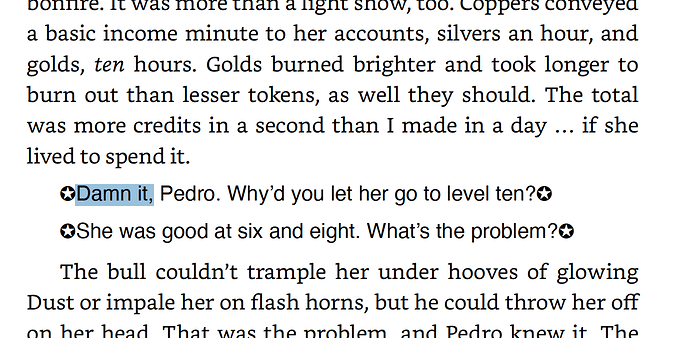I’ve been italicizing internal monologue in my novel manuscript. I’ve seen some sites that say one should not do that. What’s your opinion?
I’d get in touch with who you will be submitting the manuscript to, and your editor to see what their preferences are. Some will prefer a more obvious “syntax” for such things, but otherwise there aren’t any actual rules for this kind of thing.
You can play it safe and use styles for this. That way you can format them however it works for you as a creative tool, and set up your compiler to change the formatting to what you need, in the end.
There is a distinction to be drawn between an agent’s stream of thoughts and literal internal verbalization. We do a lot of the former and not a lot of the latter.
My two cents: You should not italicize the former, but may choose to italicize the latter.
Quick test. If you find a whole paragraph ends up in italics, you are not doing it right. We never literally internally verbalize anything of any length. One might internally verbalize an acerbic retort one would not dare say aloud, but that is the extent of it.
In fact, once you recognize the above distinction, you may quickly come to the conclusion that you want your character to internally verbalize things rarely or never, and so the italicization will more or less disappear. This is because having a character literally talk to themselves in their mind anything but rarely tends to come off as a bit hokey and unrealistic. Nancy Drew may talk to herself but that is part of why she seems unreal (and kinda hokey, albeit in a potentially endearing way).
Wish I could. No agent.
That sounds about right.
@olonoff
That’s what I do, and I also use a style for thoughts, a style for dialog across the 2099 version of the world wide web (brain to brain in effect, but not just a thought), a style for emphasis, and a style for curse words. That facilitates formatting and it’s easy to search for instances of a style or select all instances.
Clarity to the reader is most important. If you want the internal monologue to be separated in the mind of the reader, italics work fine.
+1 to @drmajorbob on setting up a separate style in Scrivener for the internal monologue. That way if an agent or editor wants it formatted differently, it will take you ten minutes to fix.
On a personal note, I prefer reading fiction where the different modes of commuication are dilineated. It makes for a breezier read, because once you’ve explained that the italics are thoughts and the green type is neural chat, you can just use them without any more explanations or declarations.
Just my 2¢
Closer to ten seconds, but yes. Here’s a bit of Babel dialog:
And here it is in the PDF Compile:
The Babel dialog is Helvetica, everything else is Bookerly. If the stars are judged too gaudy at some point, they can be changed to anything.
I think it often depends upon the point of view and the narrative style. Advice to not use it is probably coming from folks who are narrowly thinking about a particular narrative style or point of view. Their advice doesn’t apply to everything, regardless how much their wishful thinking makes them think it does.
Thomas Harris uses this to great effect in chapter 2 of The Silence of the Lambs. It’s written in third person. Clarice Starling meets the prison warden and is unimpressed with how she’s being treated by him. She has some choice words, but she keeps them to herself (and to the reader). ‘Well, eff you, Chilton!’
In third person, this is almost a get out of jail free card to see directly inside a character’s head, similar to how that is constantly available in first person. Story Grid refers to this as Free Indirect Style, and it can be a powerful tool. It also means you don’t need a ‘she thought’ tag, as the thought comes directly from the character and is not filtered through the author. Usually, the more invisible the author, the better.
But it probably should be done very sparingly. It can get old quickly.
It can also add a layer of intensity to first person. I try to limit it to when a character is having an emotional reaction or moment, or when they are in mixed company and have such a moment but don’t want to say what they’re thinking out loud. But then in first person when the scene is in real time, you can also have thoughts from the character directly that don’t need to be italicized, such as ‘I wonder what she’s up to?’, and of course thought tags are not necessary at all in first person.
I’ve also seen people write YA and do it four times a page, but that comes off as fairly amateurish.
I write in a first person conversational style in a form of present tense (not YA present tense), so I don’t need that get out of jail free card, but even in this narrative approach there are still rare moments where this can be effective.
My work is High Fantasy focus on mages… lots of magic etc. My MC is also a telepath. I use italics for telepathic communication. Also for telepathic converation between two people, I have decided ( I think) to have the POV telepath
s sid of the covnersation right margin justified and the other character’s side of the telepathic conversation left margin justified. It sort of looks like a text.
When the conversation is telepathic with one conversant but physical with the other, I still use italics for the telepathic part of the convo and normal dialogue rules for the non-telepathic.
i hope that helps

